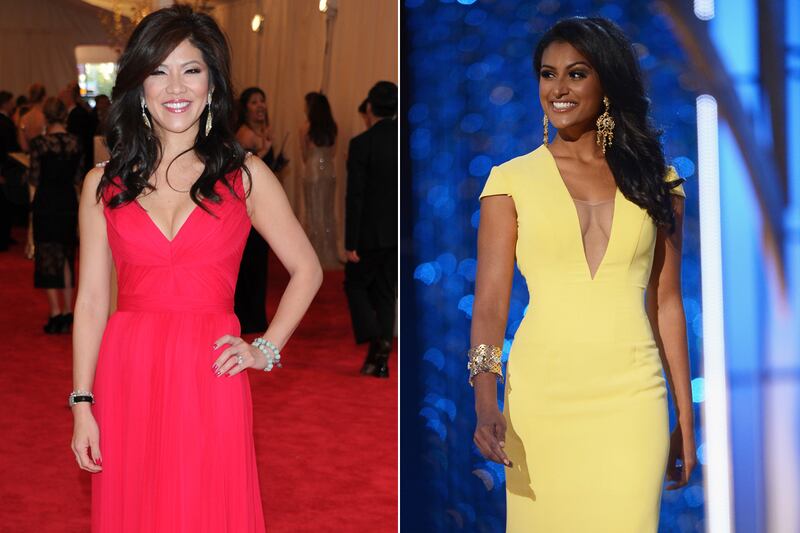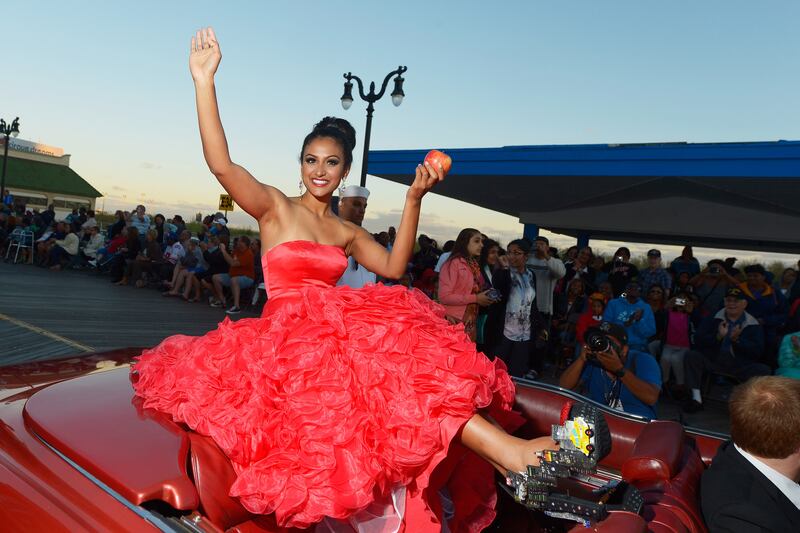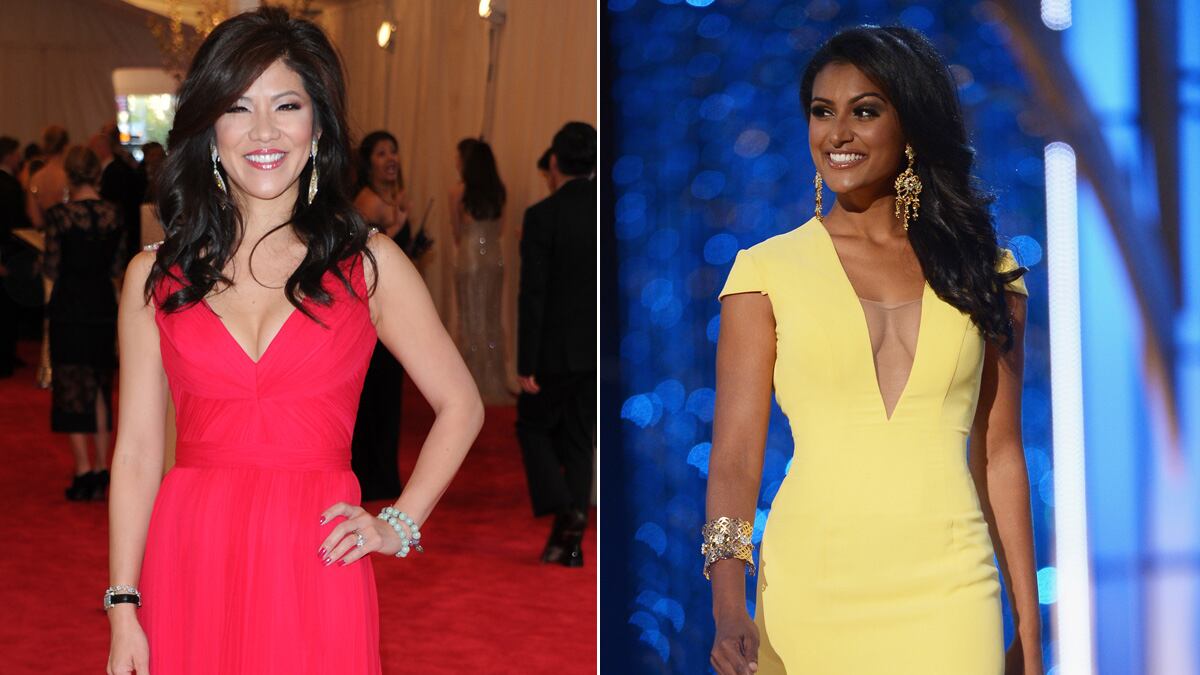
“I’ve always viewed Miss America as the girl next door, and the girl next door is evolving as diversity in America evolves,” Nina Davuluri said last weekend before becoming the first beauty queen of Indian descent to be crowned Miss America. Also on stage was runner-up Crystal Lee, a Chinese-American and Miss California 2013. “We’re making history right here, standing here as Asian-Americans,” Davuluri said of the duo.
This is not the Miss America Julie Chen is familiar with. Earlier this month, the Talk host announced on her CBS show that in the early 90s, she underwent cosmetic surgery to widen her “Asian eyes.” In response to this, Davuluri said, “I don’t agree with plastic surgery, however I can understand that from her standpoint.”
Chen’s point of reference was the original “girl next door” – the pale, wide-eyed beauty ideal of Miss Americas past — the same reference point for much of the last century for much of the world.
America’s girl next door first traveled abroad in the late 19th century. Around that time there was a “huge surge” in the global homogenization of the beauty ideal when French perfume brands (Guerlain, Coty, Chanel) first went international, says Geoffrey Jones, Isidor Straus Professor of Business History at Harvard Business School, and the author of Beauty Imagined: A History of the Global Beauty Industry.
“Western beauty ideals and the idea of Paris as the capital of beauty really spread around the world,” he tells The Daily Beast. This was “re-enforced” by Hollywood, with the use of American (largely white) celebrities in international advertising and the export of American film and television. In Glamour: A History, Stephen Gundle writes that the foreign broadcast of American beauty pageants helped perpetuate the Western beauty ideal, starting with the UK's Miss World contest in 1951 and followed a year later by Miss Universe in the U.S. “This force of homogenization was really going on through to the 1980s when there began to be a push back, which has been intensifying more recently,” says Jones.
But by the mid-1990s, Julie Chen was still feeling the pressure. As a 25-year-old reporter working at a news station in Dayton, Ohio, she was told she would never be an anchor because she was not “relatable” and her epicanthic fold made her seem disinterested (the station has since apologized). A major Hollywood agent also told the young journalist, “I cannot represent you unless you get plastic surgery to make your eyes look bigger.”

In response, Chen sought double-eyelid surgery, also known as East Asian blepharoplasty. “After I had that done, the ball did roll for me," she admitted, though she acknowledged struggling with the question of whether she gave “in to The Man.” But if Chen was giving in to The Man, so were six decades of Chinese before her.
Western consumer and beauty culture as well as Western medical technology introduced cosmetic surgery to China's big cities—such as Shanghai and Beijing —in the 1930s, says Wen Hua, a Ph.D. in anthropology and author of Buying Beauty: Cosmetic Surgery in China. “In early 19th-century China, pictures of beautiful women have very narrow eyes,” adds Geoffrey Jones. “By the end of the century, already, wide eyes were being praised.”
Today blepharoplasties and rhinoplasties (nose jobs) are "the most common operations among young people” in China, says Hua. A $2.5 billion industry, China’s cosmetic surgery market has reportedly grown 20 percent per year and is now the third largest in the world. “In my opinion, women’s anxiety about body image will be more and more captured by the ubiquitous consumer culture and the ever-expanding beauty market in China in the future,” says Hua.
While Julie Chen may embody East Asia's new beauty ideal, Davuluri does not appear to do the same for South Asia. Following her Miss America win, some in India speculated that Davuluri’s skin was too dark for a beauty pageant in her own country, which The Daily Beast’s Tunku Varadarajan dubbed "a pigmentocracy."
India’s preference for fair skin dates back “hundreds and possibly thousands of years” and cuts across the country’s social strata, says Nina Jablonski, Distinguished Professor of Anthropology at Pennsylvania State University and the author of Living Color: The Biological and Social Meaning of Skin Color and Skin: A Natural History. “The preference originated because people who had lighter skin generally didn’t have to work outdoors and so they were considered to be higher status,” she says.
Paler complexions became even more powerful with the establishment of the modern caste system, which divides India’s Hindu society into a heredity-based hierarchy. “With the establishment of the modern caste system we see mention of colors – what are called in India ‘varna’—that are associated with spiritual attributes,” explains Jablonski. “The lighter colors, especially white, came to be associated with the upper caste and with moral virtue.”
In recent years, Bollywood and fashion magazines "have increased the amplitude of the wave of social preference for lightly skinned people.” Sometimes the two work symbiotically—a number of Bollywood stars like Shah Rukh Khan promote skin lighteners in print and on TV. "This is one of the reasons why skin bleaching products have become incredibly widespread," Jablonski explains.
Traditional skin lightening juices, chemicals, and white powders have been circulating for hundreds of years, but skin bleaching products were introduced to India around the Sixties and Seventies. And it was a Western product, Fair and Lovely, that dominated the market, thanks to a savvy marketing plan that exploited the regional beauty ideal. Unilever, the British-Dutch company that manufactures it, globalized the brand – across Asia, Africa, the Caribbean, and the Middle East—by highlighting the prestige associated with pallor. “The marketing message is that if a woman is pale, she will get a good husband and she'll get a good job,” says Jones. Fair and Lovely was so successful at the beginning of the 21st century that it reportedly contributed to over half of India's $200 million skin lightening industry.
Such a valuable message has proven hard to give up. In April 2010, Vogue India released a cover populated by dark-skinned models and the headline "The Dawn of Dusk." But the cover stars were still "on the lighter side" of the range of Indian skin tones, says Jablonski. And this year’s Miss America winner is unlikely to dismantle local tradition. "I think that would help but it would be more national pride in a woman from India," explains Jablonski. She says change would require the rise of darker skinned celebrities, Bollywood stars embracing their natural color, and Fair and Lovely including moderate complexions.
But if the U.S. can change, anyone can. The Western beauty ideal was slowly replaced in the States through the Civil Rights Movement in the Sixties, de-colonization in Asia and Africa, the economic growth of countries like China and India and the growing rights of American minorities, all of which gave birth to what Jones refers to as “mosaic beauty.” In Allure’s March 2011 issue, in which 2,000 men and women in the U.S. were polled, 69 percent believed there is no longer an “all-American” look.
In short, the new Western beauty ideal is no ideal at all. How beautiful is that?






